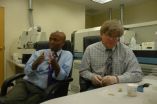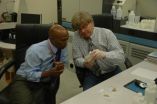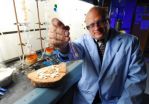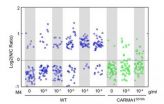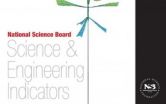(Press-News.org) Her name is Naia, and for thousands and thousands of years, the skeleton of this young woman was buried underwater in an elaborate cave system in the Yucatan Peninsula after she had apparently fallen into what was then a dry deep pit.
Now, a team of researchers, including Professor Yemane Asmerom and Research Scientist Victor Polyak at the University of New Mexico's Department of Earth and Planetary Sciences, have accurately determined the age of the oldest-known, well-preserved human skeleton. Naia was one of the earliest inhabitants of the Americas and has helped resolve a long-standing question of the link between ancestral Americans and modern Native Americans.
The research, titled Late Pleistocene Human Skeleton and mtDNA Link Paleoamericans and Modern Native Americans, published Thursday in the journal Science, paints a picture of a Paleoamerican skeleton with Native American DNA haplogroup that links Paleoamericans with modern Native Americans.
"The challenge, to date, has been finding a fossil of an adult complete enough to do the morphology work, preserved enough to have mitochondrial DNA, while at the same time having appropriate material for dating," Asmerom said. "Naia, the most complete human skeleton found, meets those requirements. Our lab here at UNM was ideally suited to do the dating work and thus why we were part of this international collaboration."
Naia's skull shape does not look like those of Native Americans, but the Beringian-derived mitochondrial DNA (mtDNA) D1 haplogroup (D1) directly links her to the modern Native peoples of the Americas. Her ancestors' origins were in Beringia, an area once above water between Siberia and North America. The D1 haplotype likely developed after early humans moved into the area from elsewhere in Asia. The physical differences between Paleoamericans and Native Americans, likely resulted from in situ evolution rather than having a separate ancestry.
The project was initiated by the Mexican Institute for Anthropology and History. The near-complete human skeleton, with an intact cranium and preserved DNA, was found along with other extinct fauna by a team of scientific divers led by Alberto Nava Blank from Proyecto de Espeleologia de Tulum (PET) in the Sac Actun cave system located off the eastern Yucatan Peninsula in 2007. The divers coined the location where Naia was found as "Hoyo Negro" (Black Hole) because of the hole's vast impenetrable darkness.
The pit, described as a deep, massive chamber 200-ft. in diameter and 20- to 190-feet from top to bottom, was so vast it absorbed all visible light from powerful underwater lights that could not see the other side of the chamber.
To unravel the mystery of Naia's age, Asmerom and Polyak first conducted uranium-thorium dating of one of her teeth, and while those first results were promising, they were inconclusive. However, more clues were left behind in the cave. Mineral deposits in water dripping from the roof of the limestone cave splashed onto the cave floor, and mist from those drip water impacts formed delicate rosette-looking speleothems (cave formations) that the divers called 'florets.' It turned out the average of the tooth data also converged to the age obtained from the mineral deposit data.
Independent radiocarbon data were provided by two labs in an effort spearheaded by Douglas Kennett of Penn State University. A third approach to the age constraint was provided by the UNM and Penn State teams consisting of refining regional sea-level data, which provides the minimum age at which the cave was inundated. Naia's resting place is now 130 feet below present-day sea-level.
The refined sea-level curve showed that the site, now 42 meters under water, would have become submerged during sea level rise between 9,700 and 10,200 years ago, long after Naia and the other extinct animals likely fell into it.
"Because the florets grew on the human bones, we knew that dating them would give us a minimum age for the bones," Polyak said. "And again, given that Hoyo Negro pit was dry when Naia made her way to the bottom, the florets had to have grown between the time of her death and 10,000 years ago when the bottom of the pit became submerged by brackish water because of rising sea level. Therefore, the oldest pieces of florets provided the oldest minimum age."
Having perfected this method of speleothem chronology with near pinpoint accuracy in previous research over the years in their state-of-the-art Radiogenic Isotope Laboratory at UNM that Asmerom leads, they were equipped to date the delicate florets that adhered to the top of Naia's body after she fell in the cave. The radiocarbon dating of the DNA tooth enamel yielded a maximum age for Naia of 12,900 years ago, while UNM's uranium-thorium results provided a minimum age of 12,000 years ago, confirming that Naia was a Paleoamerican.
"Years of effort to develop our methodology, including technical and the refinement of the half-lives of short-lived isotopes of the decay of uranium, has paid dividends," Asmerom said. "We are gratified by the fact that we played a crucial role in helping answer one of the outstanding questions in anthropology. At UNM we spent a fair amount of effort and resources on this project; we believe that the product justifies the investments."
INFORMATION:
Others involved on the 15-person team included: James C. Chatters, DirectAMS; Brian Kemp, Washington State University; Patricia A. Beddows, Northwestern University; Eduard Reinhardt, McMaster University, Ontario; Joaquin Arroyo-Cabrales, INAH; Deborah A. Bolnick, University of Texas at Austin; Ripan S. Malhi, University of Illinois; Dominique Rissolo, Waitt Institute; Shanti Morell-Hart, Stanford University; Thomas W. Stafford, Jr., Aarhus University, Denmark.
The Mexican Instituto Nacional de Antropología e Historia, The University of New Mexico, the National Geographic Society, the Pennsylvania State University, the National Science Foundation, the Archaeological Institute of America, Waitt Institute, the University of Texas at Austin and DirectAMS provided support this project.
UNM plays major role in establishing link between ancient and modern Native-Americans
Asmerom, Polyak instrumental in determining age of most complete human skeleton ever found
2014-05-15
ELSE PRESS RELEASES FROM THIS DATE:
Making money from lignin: Roadmap shows how to improve lignocellulosic biofuel biorefining
2014-05-15
When making cellulosic ethanol from plants, one problem is what to do with a woody agricultural waste product called lignin. The old adage in the pulp industry has been that one can make anything from lignin except money.
A new review article in the journal Science points the way toward a future where lignin is transformed from a waste product into valuable materials such as low-cost carbon fiber for cars or bio-based plastics. Using lignin in this way would create new markets for the forest products industry and make ethanol-to-fuel conversion more cost-effective.
"We've ...
UH researchers find definitive evidence of how zeolites grow
2014-05-15
Researchers have found the first definitive evidence of how silicalite-1 (MFI type) zeolites grow, showing that growth is a concerted process involving both the attachment of nanoparticles and the addition of molecules.
Both processes appear to happen simultaneously, said Jeffrey Rimer, an engineering professor at the University of Houston and lead author of a paper published Thursday in the journal Science.
He said a second component to the research could have even more lasting impact. He and researcher Alexandra I. Lupulescu used a new technique allowing them to view ...
Anti-craving drug and counseling lower alcohol harm in homeless, without sobriety demands
2014-05-15
Chronically homeless, alcohol-dependent individuals might benefit from a new intervention that does not require them to stop or even reduce drinking, according to the results of a preliminary study in Seattle.
Participants in the 12-week pilot program received monthly injections of an anti-craving medication, extended-release naltrexone. They also met regularly with study physicians to set their own goals for treatment and to learn to be safer in their use of alcohol.
"Abstinence-based alcohol treatment has not been effective for or desirable to many homeless people ...
UTHealth research: Children of parents in technical jobs at higher risk for autism
2014-05-15
HOUSTON – (May 15, 2014) – Children of fathers who are in technical occupations are more likely to have an autism spectrum disorder, according to researchers at The University of Texas Health Science Center at Houston (UTHealth).
The findings will be presented Friday at the International Meeting for Autism Research in Atlanta.
During participation in the LoneStar LEND program, first author Aisha S. Dickerson, Ph.D., a researcher at UTHealth's Center for Clinical and Translational Sciences, used the United States government's Standard Occupational Classification system. ...
B cells produce antibodies 'when danger calls, but not when it whispers'
2014-05-15
The immune system's B cells protect us from disease by producing antibodies, or "smart bullets," that specifically target invaders such as pathogens and viruses while leaving harmless molecules alone. But how do B cells determine whether a threat is real and whether to start producing these weapons?
An international team of life scientists shows in the May 16 issue of the journal Science how and why these cells respond only to true threats.
"It is critical for B cells to respond either fully or not at all. Anything in between causes disease," said the study's senior ...
Researchers show emissions from forests influence very first stage of cloud formation
2014-05-15
PITTSBURGH—Clouds play a critical role in Earth's climate. Clouds also are the largest source of uncertainty in present climate models, according to the latest report of the Intergovernmental Panel on Climate Change. Much of the uncertainty surrounding clouds' effect on climate stems from the complexity of cloud formation.
New research from scientists at the CLOUD (Cosmics Leaving OUtdoor Droplets) experiment at CERN, including Carnegie Mellon University's Neil Donahue, sheds light on new-particle formation — the very first step of cloud formation and a critical component ...
New data show how states are doing in science
2014-05-15
The newly updated, online, interactive state data tool allows policymakers, educators and other users to discern trends in education, science and research in each of the 50 states. This free resource supplements the state data in the 2014 Science and Engineering Indicators report, the premier source of information and analysis of the nation's position in science and engineering education and research. The biennial report is published by the National Science Board, the policy making body of the National Science Foundation (NSF).
The tool features 59 state indicators of ...
UH Case Medical Center neurosurgeon uses depth electrodes for speech mapping
2014-05-15
CLEVELAND -- At the 2014 American Association of Neurological Surgeons Annual Meeting, neurosurgical researchers from University Hospitals (UH) Case Medical Center presented results from a small study looking at deep brain electrode implantation as a possible alternative to the traditional WADA test used prior to epilepsy surgery.
The WADA test is considered the gold standard for identifying the side of the brain for speech dominance. In the WADA test, doctors put one half of a patient's brain to sleep for a few minutes using medication and then have the patient read ...
Study: Targeted funding can help address inequities in early child care programs
2014-05-15
CORVALLIS, Ore. – The quality of early child care and education programs is influenced both by funding and by the characteristics of the communities in which the programs operate, new research from Oregon State University shows.
The findings indicate that law- and policy-makers may need to consider the demographics of communities when making funding decisions about early childhood programs, said Bridget Hatfield, an assistant professor in OSU's College of Public Health and Human Sciences.
That's especially important now because many states, including Oregon, are adopting ...
Fires in San Diego County blazing
2014-05-15
The single fire that ignited and split into nine separate fires still blazes in Southern California today. Firefighters are hoping for a break today (Thursday, May 15, 2014) but it doesn't look like luck may be on their side. Conditions continue to be bone dry with unseasonal heat (98-106 degrees) and the Santa Ana winds are kicking up and allowing these fires to easy jump fire lines. This particular fire started on Wednesday as a single fire and within a day is now nine separate fires which have burned close to 10,000 acres. These fires are threatening more than just ...
LAST 30 PRESS RELEASES:
Numbers in our sights affect how we perceive space
SIMJ announces global collaborative book project in commemoration of its 75th anniversary
Air pollution exposure and birth weight
Obstructive sleep apnea risk and mental health conditions among older adults
How talking slows eye movements behind the wheel
The Ceramic Society of Japan’s Oxoate Ceramics Research Association launches new international book project
Heart-brain connection: international study reveals the role of the vagus nerve in keeping the heart young
Researchers identify Rb1 as a predictive biomarker for a new therapeutic strategy in some breast cancers
Survey reveals ethical gaps slowing AI adoption in pediatric surgery
Stimulant ADHD medications work differently than thought
AI overestimates how smart people are, according to HSE economists
HSE researchers create genome-wide map of quadruplexes
Scientists boost cell "powerhouses" to burn more calories
Automatic label checking: The missing step in making reliable medical AI
Low daily alcohol intake linked to 50% heightened mouth cancer risk in India
American Meteorological Society announces Rick Spinrad as 2026 President-Elect
Biomass-based carbon capture spotlighted in newly released global climate webinar recording
Illuminating invisible nano pollutants: advanced bioimaging tracks the full journey of emerging nanoscale contaminants in living systems
How does age affect recovery from spinal cord injury?
Novel AI tool offers prognosis for patients with head and neck cancer
Fathers’ microplastic exposure tied to their children’s metabolic problems
Research validates laboratory model for studying high-grade serous ovarian cancer
SIR 2026 delivers transformative breakthroughs in minimally invasive medicine to improve patient care
Stem Cell Reports most downloaded papers of 2025 highlight the breadth and impact of stem cell research
Oxford-led study estimates NHS spends around 3% of its primary and secondary care budget on the health impacts of heat and cold in England
A researcher’s long quest leads to a smart composite breakthrough
Urban wild bees act as “microbial sensors” of city health.
New study finds where you live affects recovery after a hip fracture
Forecasting the impact of fully automated vehicle adoption on US road traffic injuries
Alcohol-related hospitalizations from 2016 to 2022
[Press-News.org] UNM plays major role in establishing link between ancient and modern Native-AmericansAsmerom, Polyak instrumental in determining age of most complete human skeleton ever found
